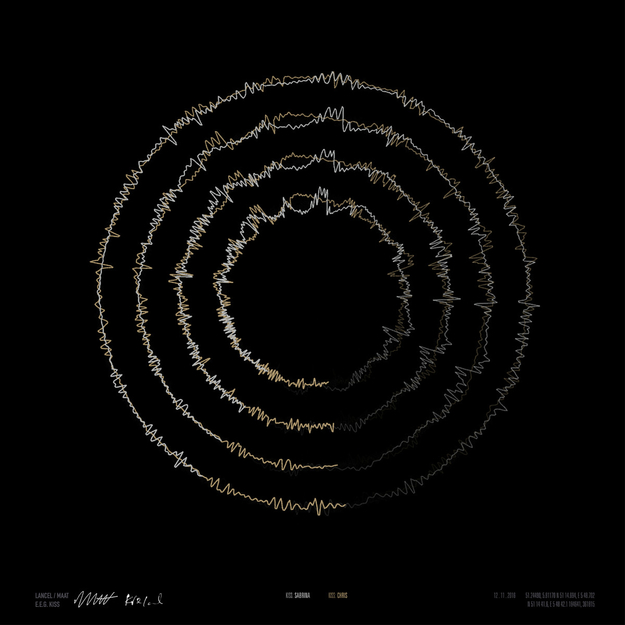The research and art of Karen Lancel and Herman Maat (Lancel/Maat) explores intimacy and the body within a technological space. Their work has become increasingly urgent since the outbreak of the Covid19 pandemic as physical meetings have been marked as dangerous and illegal. Humans are social beings; we rely on physical touch and sensory connections with others and the strange and sudden changes to our physical boundaries and relationships have challenged all of us. In this challenge, many of us turned to technology to facilitate our social needs. How far can technology go in facilitating this need for intimacy and how can we manipulate technology to further this?
As our experience of others becomes increasingly mediated by technology, Lancel/Maat’s research shows us one way that data can interact with our physical bodies. In Lancel/Maat’s performance installation, Intimacy Agents, participants are invited to become ‘co-researchers’ and kiss wearing an E.E.G headset. Their brainwaves are measured, and in real-time the data becomes a visual spectacle beneath the participants and a soundscape encircles the audience.
LANCELMAAT Stedelijk Museum - https://www.lancelmaat.nl/work/e.e.g-kiss/ 
In this, the private sensory experience of a kiss is made into a public sensory experience using technology. Thus, in Lancel/Maat’s work technology no longer opposes humans and intimacy, instead, it becomes a collaborator in creating a new type of intimacy. They use technology in such a way that two people kissing doesn’t automatically ostracise the rest of the room but aims to connect them through a shared experience.
This research could reframe the way we see technology: instead of a tool one is only using because we cannot meet others, but a tool to create intimacy amongst strangers. Is there a way that porn, for example, could be a more collaborative experience using biometric data? Perhaps the experience of watching people kiss online could create a sense of intimacy between the audience and the kissers, as in this art piece. What if there was a community of people sending videos of themselves kissing, would this help us experience more intimacy during the lockdown?
Each kiss is downloaded and saved as an ‘E.E.G Kiss Portrait’ that can be embroidered on silk or printed on aluminium. Thus, each unique kiss becomes a tangible object that endures beyond the co-researcher kissers that began the process. How much of ourselves can be embedded in such ‘portraits’? And do you feel a type of closeness or intimacy in viewing this piece? Would you want a portrait of the brainwaves of strangers, friends, or yourself kissing? Perhaps this is better seen as a memory of an experience, rather than a translation of intimacy.
LANCELMAAT Kiss Portrait - https://www.lancelmaat.nl/work/e.e.g-kiss/ 
In one sense, Lancel/Maat’s work could demonstrate that hybridity between humans and technology is possible in their installation as data collection becomes a positive force that connects strangers. But how does this translate to us in a time of lockdown, are you convinced that this research can extend the possibilities of our body? In a time in which humans are turning to technology because physical intimacy is impossible, perhaps this research can help to expand our use of technology and come up with new ways to be intimate online. Or can it help the pornography industry consider new ways to create intimacy for its audience?
Is our body schema, our mental representation of our physical body, changed by this artistic experiment and how often can our online data be seen as an expression of our physical body? When you have your next zoom pub quiz, ask yourself how much of yourself is translated across the internet to your loved ones. Is your need for intimacy satisfied in part, or in new ways and what role does data play in your body schema?
